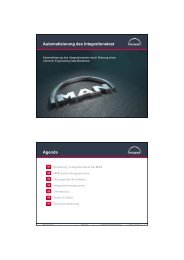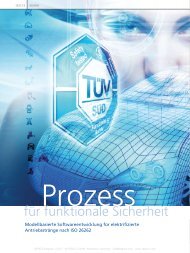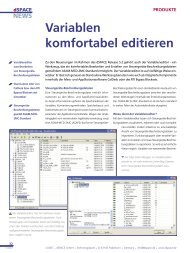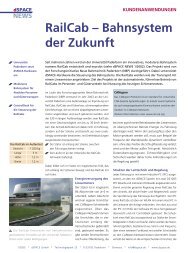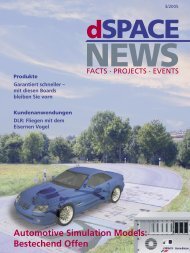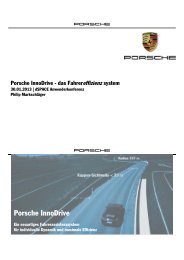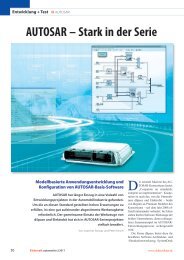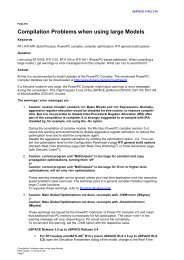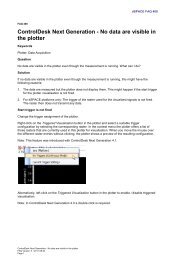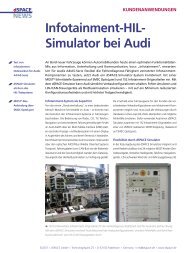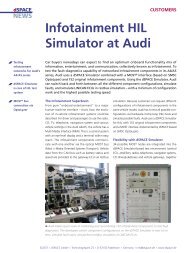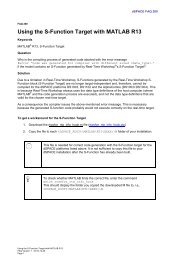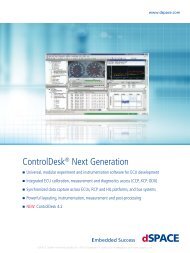magazinE - dSPACE
magazinE - dSPACE
magazinE - dSPACE
Create successful ePaper yourself
Turn your PDF publications into a flip-book with our unique Google optimized e-Paper software.
pAGe 18 BRAKe-BY-WIRe SYSTeMS<br />
VEHICLE CAN<br />
S1<br />
S2<br />
S3<br />
OPN<br />
PU<br />
SCA<br />
SC B<br />
EPB<br />
+<br />
–<br />
SAFE POWER PU<br />
BUB PU<br />
SPWM_A<br />
SPWM_B<br />
BUB_EPB<br />
PRIVATE_CAN<br />
KL 15<br />
Actuators/Sens.<br />
Driver<br />
WU<br />
MuC SuC<br />
WU<br />
EM<br />
WU<br />
EM<br />
MuC WU SuC<br />
Driver<br />
KL 30<br />
Actuators/Sens.<br />
FR<br />
Wheel Speed Wheel Speed<br />
ECCU<br />
uC1 BuB BuB 1<br />
Monitoring<br />
uC3<br />
BuB BuB 2<br />
Monito-<br />
uC2 ring<br />
BOOT_CAN_ENABLE<br />
ECCU_CAN<br />
BUB1_FR<br />
BUB1_RL<br />
SENSOR_CAN<br />
VDS<br />
BUB2_RR<br />
BUB2_FL<br />
FL RL<br />
Wheel Speed Wheel Speed<br />
System architecture and communication structure of the electrical brake based on a 12-V vehicle electrical system.<br />
In addition to basic automation,<br />
the user can also use functionalities<br />
such as:<br />
n Implementation of the graphical<br />
user interface to handle and<br />
configure the test system<br />
n Eventcontrolled layout and<br />
experiment management<br />
n Test automation and test management<br />
with IABG software modules<br />
in conjunction with Automation<br />
Desk to configure and generate<br />
test sequences<br />
n Automatic evaluation and<br />
generation of test reports<br />
n Access to ECU operating states,<br />
variables and parameters via a<br />
diagnostic interface<br />
n Evaluation software to display<br />
measurement data graphically<br />
WL1<br />
WL2<br />
WL3<br />
Test automation and<br />
Failure Simulation<br />
The task of test automation is to define<br />
single tests individually, execute<br />
them sequentially in a coordinated<br />
manner, and abort test execution in<br />
the event of a failure. A test report<br />
and test run documentation are automatically<br />
generated for each test.<br />
The user can configure the form and<br />
contents of the test report.<br />
Test automation based on AutomationDesk<br />
was developed on the HIL<br />
test system. AutomationDesk lets<br />
the user freely define test sequences<br />
that are executed by the test bench<br />
automation system. This gives the<br />
user the greatest possible flexibility<br />
when specifying and implementing<br />
tests. The test database that was set<br />
RR<br />
Actuators/Sens.<br />
Driver<br />
WU<br />
MuC SuC<br />
SPWM_A<br />
SPWM_B<br />
PRIVATE_CAN<br />
WU<br />
EM<br />
WU<br />
EM<br />
MuC WU SuC<br />
Driver<br />
Actuators/Sens.<br />
TO_DASHBOARD<br />
TO_DISPLAY<br />
up now contains approx. 800 single<br />
tests of varying complexity and is<br />
constantly being added to.<br />
The automated environment<br />
provides access to the requirements,<br />
test specifications, and test results<br />
via a direct connection to the test<br />
configuration and management tool<br />
that is used in the development and<br />
test process.<br />
One of the applications for the test<br />
automation system is inserting fault<br />
scenarios to analyze system behavior.<br />
The following fault types can be<br />
implemented on the test bench:<br />
n Cable harness faults<br />
n Signal faults<br />
n Communication faults in CAN<br />
and FlexRay



